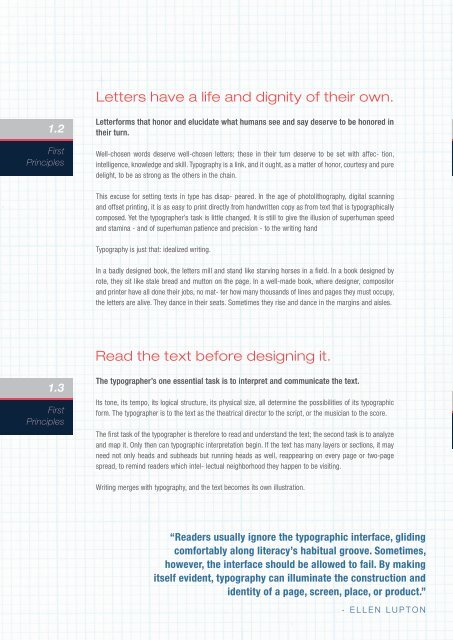5 Trick Pony Brand Guidelines v3
You also want an ePaper? Increase the reach of your titles
YUMPU automatically turns print PDFs into web optimized ePapers that Google loves.
Letters have a life and dignity of their own.<br />
1.2<br />
First<br />
Principles<br />
Letterforms that honor and elucidate what humans see and say deserve to be honored in<br />
their turn.<br />
Well-chosen words deserve well-chosen letters; these in their turn deserve to be set with affec- tion,<br />
intelligence, knowledge and skill. Typography is a link, and it ought, as a matter of honor, courtesy and pure<br />
delight, to be as strong as the others in the chain.<br />
This excuse for setting texts in type has disap- peared. In the age of photolithography, digital scanning<br />
and offset printing, it is as easy to print directly from handwritten copy as from text that is typographically<br />
composed. Yet the typographer’s task is little changed. It is still to give the illusion of superhuman speed<br />
and stamina - and of superhuman patience and precision - to the writing hand<br />
Typography is just that: idealized writing.<br />
In a badly designed book, the letters mill and stand like starving horses in a field. In a book designed by<br />
rote, they sit like stale bread and mutton on the page. In a well-made book, where designer, compositor<br />
and printer have all done their jobs, no mat- ter how many thousands of lines and pages they must occupy,<br />
the letters are alive. They dance in their seats. Sometimes they rise and dance in the margins and aisles.<br />
Read the text before designing it.<br />
1.3<br />
First<br />
Principles<br />
The typographer’s one essential task is to interpret and communicate the text.<br />
Its tone, its tempo, its logical structure, its physical size, all determine the possibilities of its typographic<br />
form. The typographer is to the text as the theatrical director to the script, or the musician to the score.<br />
The first task of the typographer is therefore to read and understand the text; the second task is to analyze<br />
and map it. Only then can typographic interpretation begin. If the text has many layers or sections, it may<br />
need not only heads and subheads but running heads as well, reappearing on every page or two-page<br />
spread, to remind readers which intel- lectual neighborhood they happen to be visiting.<br />
Writing merges with typography, and the text becomes its own illustration.<br />
“Readers usually ignore the typographic interface, gliding<br />
comfortably along literacy’s habitual groove. Sometimes,<br />
however, the interface should be allowed to fail. By making<br />
itself evident, typography can illuminate the construction and<br />
identity of a page, screen, place, or product.”<br />
- ELLEN LUPTON





